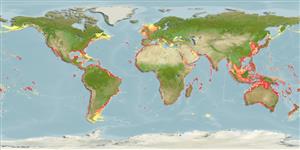Preferred temperature (Ref.
115969): 11.3 - 27.9, mean 23.2 (based on 3258 cells).
Phylogenetic diversity index (Ref.
82804): PD
50 = 0.5000 [Uniqueness, from 0.5 = low to 2.0 = high].
Bayesian length-weight: a=0.01230 (0.01110 - 0.01363), b=2.93 (2.90 - 2.96), in cm Total Length, based on LWR estimates for this species (Ref.
93245).
Trophic level (Ref.
69278): 2.5 ±0.17 se; based on food items.
Resilience (Ref.
120179): Medium, minimum population doubling time 1.4 - 4.4 years (K=0.09-0.15; tm=2-6; tmax=16; Fec=1.6 million).
Prior r = 0.51, 95% CL = 0.34 - 0.77, Based on 12 stock assessments.
Fishing Vulnerability (Ref.
59153): Moderate vulnerability (43 of 100).
Climate Vulnerability (Ref.
125649): High vulnerability (59 of 100).
